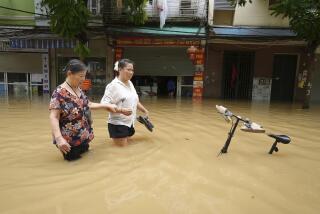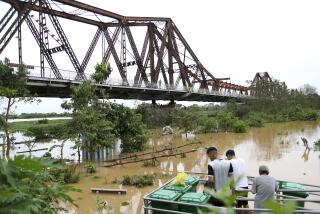2 Million Evacuated as China Flood Toll Rises to 567
- Share via
BEIJING — The death toll in two weeks of flooding in areas throughout China has risen by 31 to at least 567, with roads and rail lines cut in its southern industrial heartland and more rains forecast, the government said Saturday.
Another 165 people were missing and more than 2.4 million have been evacuated from flood-prone areas, mostly in the south, state media said, citing the Ministry of Civil Affairs.
State television showed people clinging to rubber hoses to avoid being swept away. Soldiers placed babies in straw baskets to be lowered by pulleys into wooden rowboats. Soldiers and civilians formed brigades to fill and carry sandbags to shore up faltering dams and riverbanks, in a country where most labor is still done by hand.
Roads and railroads were cut in the southern province of Guangdong, the heart of the country’s export-driven manufacturing industries, although there was no indication of major disruptions in exports. The province is also China’s most populous, with 100 million people.
The Pearl River, a major trade route that flows through the province’s southern business center, was suffering “the largest flood peak in the region’s history,” the official New China News Agency said.
Economic losses were estimated at $2.8 billion, the China Daily newspaper said. It said about 60% of those losses were in Guangdong and other southern provinces. President Hu Jintao ordered local authorities to check the status of flood dikes and reservoirs, New China News Agency said.
Hu was quoted as saying that “any hidden threat must be dealt with in time.”
The China Daily said 4,000 railway workers were sent to repair landslide damage on the main Beijing-Hong Kong railroad. Traffic on the line was suspended for a second day Saturday, and officials said it wasn’t clear when it would be back in service.
A front-page photo Friday in the Guangzhou Daily newspaper, published in Guangdong’s provincial capital, showed floodwaters reaching near the top of telephone poles.
The high water levels could spread sewage, polluting drinking water and raising health risks as well as damaging crops, said Alistair Henley, the Beijing representative of the International Federation of Red Cross and Red Crescent Societies.
“There will be a lot of suffering, particularly for the rural people,” Henley said.
The nationwide death toll was higher than in most of the rainy seasons of the last decade -- though still below that of 1998, when 4,150 people were killed in summer flooding in central and northeastern China.
China suffers hundreds of flood-related deaths every year during its June-August rains.
More to Read
Sign up for Essential California
The most important California stories and recommendations in your inbox every morning.
You may occasionally receive promotional content from the Los Angeles Times.










